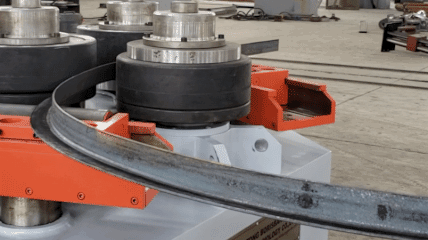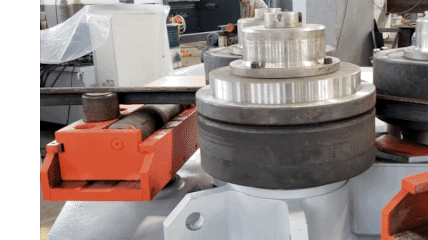Key Points: Angle profiles are asymmetric and often twist during angle rolling. The guide rollers must apply an external force during rolling to correct and minimize deformation.
The angle rolling process uses three-roll or four-roll profile bending machines to apply progressive pressure, gradually shaping angle steel to the required radius and form.
- This process includes four methods: Angle Leg-Out, Angle Leg-In, Angle Heel-Out, and Angle Heel-In.
- Profile bending machines ensure precision in off-axis bending, multi-radius bending, and forming complex profiles with varying radii.
- They efficiently roll Carbon steel, Stainless steel, Aluminum, Titanium, and Copper.
Angle Profile Bending Method: Toe Out
Angle profiles are asymmetric and often twist during angle rolling. To correct and minimize deformation, the guide rollers must apply an external force during the rolling process.
Key points for angle profile bending with Toe Out: Slowly adjust the 3D guide rollers to prevent outward twisting during angle profile bending.
Angle Profile Bending Method: Toe In
The Toe In angle rolling process is similar to the Toe Out process. During angle profile bending, deformation occurs in two directions, requiring 3D guide rollers and an anti-distortion device. This device adjusts through rotating rollers, applying an external force to resist deformation.
Note: Angle rolling in the Toe In process causes more deformation, requiring a larger minimum bending radius than Toe Out.


The PBC profile bending machine includes an anti-distortion device for angle rolling, ensuring high-quality results. See Figure B.
Angle Rings in Angle Rolling
In some regions, Angle Rings are also referred to as Angle Steel Flanges.
Angle Rings: Toe Out vs. Toe In
Angle Rings can be categorized into two types: Toe Out (Standard Rolling), where the opening faces outward, and Toe In (Reverse Rolling), where the opening faces inward. Achieving perfectly perpendicular 90° edges without distortion is challenging due to the material’s physical properties.
Angle Rolling – Toe Out (Standard Rolling)
During angle rolling with a Toe Out orientation, the outer edge undergoes tension while the inner vertical edge experiences compression. This imbalance in force leads to deviations from a perfect 90° angle and may cause wrinkling, especially in 5# and larger angle profiles. However, for 3# and 4# angle profiles with a bending diameter above 600mm, wrinkling is less pronounced.
For a deeper understanding of Angle Profile Bending techniques, explore our detailed guide here: Angle Profile Bending.